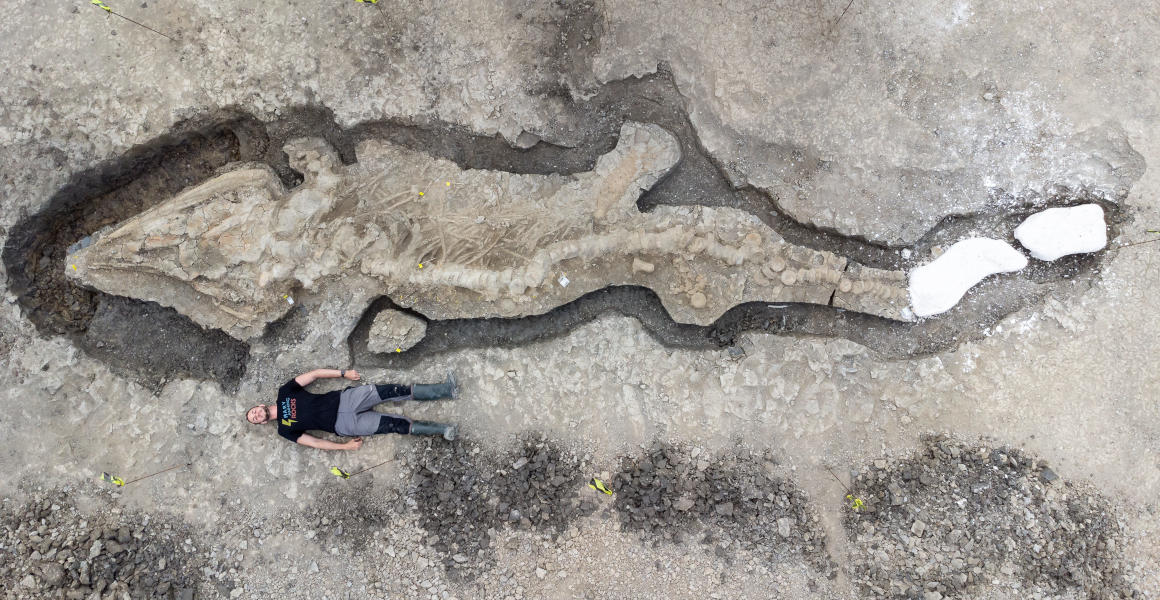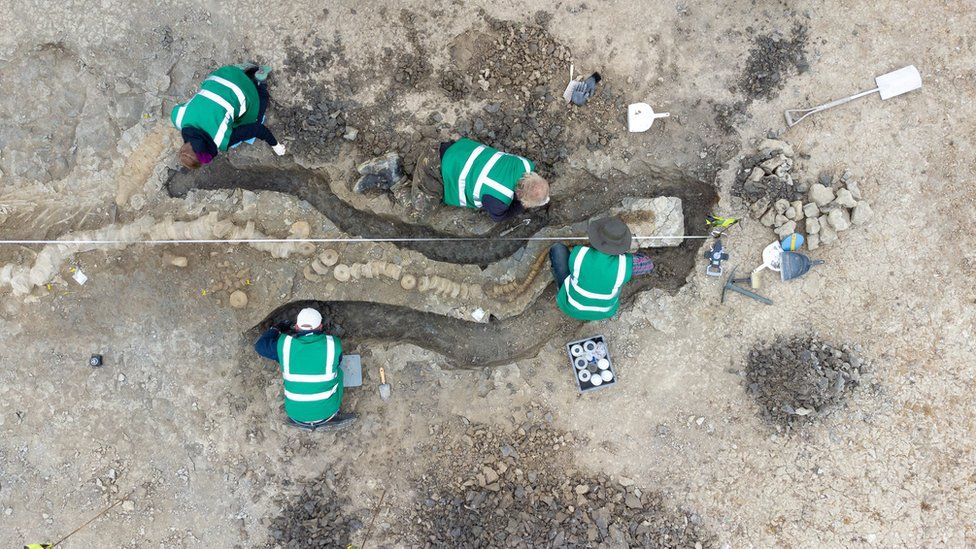The remains of an Ichthyosaur have been uncovered in Rutland, England. Ichthyosaur lived between 250-90 million years ago, and could grow to be 13 meters (43 feet) long. The specimen discovered in this photo was 10 meters long, and is the largest discovery of its kind in the U.K.
The ichthyosaur specimen, thought to be Temnodontosaurus trigonodon, measures around 10 metres in length.

The largest and most complete ichthyosaur ever found in the UK has been unearthed in the nation’s smallest county.
The ancient marine reptile, measuring more than 10 metres long, was discovered during maintenance work on Rutland Water in February where it once swam the oceans over 180 million years ago.
There are hopes to learn more about an enigmatic group of marine reptiles that lived alongside the dinosaurs after a well-preserved specimen was uncovered in Rutland.
The ichthyosaur was uncovered at the Rutland Water Nature Reserve after a lagoon island was drained for landscaping in February 2021. The specimen was then painstakingly excavated in August and September before being lifted out of the clay.
Researchers hope to study the ancient reptile to find out more about how it may have lived hundreds of millions of years ago, and help identify the fossils of its relatives.

Dr Dean Lomax, a palaeontologist who specialises in ichthyosaurs, says, ‘Britain is the birthplace of ichthyosaurs – their fossils have been unearthed here for over 200 years, with the first scientific findings dating back to Mary Anning and her discoveries along the Jurassic Coast.
‘Despite the many ichthyosaur fossils found in Britain, it is remarkable to think that the Rutland specimen is the largest skeleton ever found in the UK. It is a truly unprecedented discovery and one of the greatest finds in British palaeontological history.’
The partnership which uncovered the specimen hopes to keep it in Rutland, with funds being raised towards ensuring it stays in the local community.

Ichthyosaurus acutirostris and its relatives were among the top predators roaming the seas over 150 million years ago. Image © The Trustees of the Natural History Museum, London
What are ichthyosaurs?
Ichthyosaurs are a group of marine reptiles which were contemporaries of the dinosaurs, emerging around 250 million years ago during the Triassic Period. Reaching up to 25 metres in length and possessing many sharp teeth, they are thought to have been the top predators of Jurassic oceans.
Despite the discovery of many ichthyosaur species, including one named after Sir David Attenborough, the evolutionary history of the group is uncertain. While there are many complete specimens, they are mostly found in small areas of Western Europe and North America, leaving many gaps in the fossil record.
Some of the earliest specimens which are recognisably ichthyosaur-like are found around 240 million years ago, with studies suggesting that they probably descended from land-dwelling animals which returned to the sea, something the ancestor of whales and dolphins would later do.
Having taken the plunge, the ichthyosaurs adapted to become the oceans’ top predator over the next 150 million years, with preserved tissue and fossils found with their last meal still inside suggesting the reptiles ate large amounts of fish and squid.
After becoming extinct around 90 million years ago, their fossils would be among some of the oldest to be found in the UK, with Mary Anning and her brother Joseph discovering the first specimen in the early 1800s.
Like the Anning siblings, who discovered their finds while walking, the Rutland ichthyosaur was chanced upon by Joe Davis as he crossed the drained lagoon.
‘I saw something that looked organic sticking out of the mud,’ he says. ‘I’ve previously found whale and dolphin skeletons while working in the Hebrides, and these appeared similar. Along with my colleague Paul Trevor, we followed what indisputably looked like a spine and then something further along that could have been a jawbone. We couldn’t quite believe it!’
The find has been tentatively identified as Temnodontosaurus trigonodon. These were a group of large ichthyosaurs, measuring up to 12 metres long, with different species adapting to eat a range of hard and soft prey.
If confirmed, the Rutland specimen would be the first of its species discovered in the UK.

The ichthyosaur was buried in clay underneath Rutland Water. Image © brett_land/Shutterstock
How was the Rutland ichthyosaur removed?
Following the specimen being uncovered, a team of expert and amateur palaeontologists were assembled to reveal its true extent.
They found that it was around 10 metres long when fully excavated – about double the height of a giraffe – and was almost complete. It is significantly larger than two previous ichthyosaurs that were found in Rutland Water during its construction in the 1970s.
To remove the specimen, it was wrapped in a jacket of wooden splints encased in plaster of paris. This allowed the ichthyosaur, which weighs over two tonnes altogether, to be lifted out in sections.
Nigel Larkin, a specialist palaeontological conservator who helped recover the fossils, says, ‘The block containing the massive two-metre long skull, the Jurassic clay in which it lies, and the encasing plaster jacket weighs just under a tonne, while the block containing the body section weighs about a tonne and a half. It’s not often you are responsible for safely lifting a very important but very fragile fossil weighing that much.
‘It is a responsibility, but I love a challenge. It was a very complex operation to uncover, record, and collect this important specimen safely.’
While scientists work on researching the specimen, a fundraising effort has been launched to keep it in Rutland, where it has been for the past 180 million years. It is not yet clear what this will entail, or what will happen to the specimen should the fundraising goals not be reached.